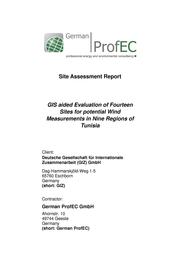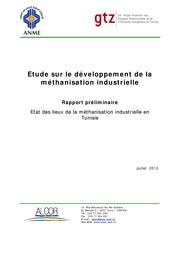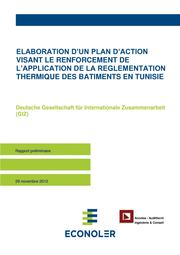Promotion of Renewable Energies and Energy Efficiency in Tunisia
Overview
Tunisia is heavily dependent on fossil fuels (oil, natural gas). Energy consumption increases by about 4% per year. The resulting greenhouse gas (GHG) emissions have harmful effects on the environment and the global climate. The competitiveness of Tunisian enterprises is affected by the energy intensity of the Tunisian economy. However, the potential of renewable energy (RE) and energy efficiency (EE) is still under-exploited.
In order to meet these challenges in the energy sector, the National Agency for Energy Conservation (ANME), a public institution under the supervision of the Ministry of Industry, was established in 1985 to ensure the implementation of a national policy in the field of energy management, including the promotion of energy efficiency and renewable energy.
In December 2003, the project, “Promotion of Renewable Energy and Energy Efficiency” (ER2E) was initiated in the context of Tunisian-German cooperation to assist the ANME in developing appropriate approaches for energy management in Tunisia. The project is funded by the Federal Ministry for Economic Cooperation and Development (BMZ) and implemented by the Deutsche Gesellschaft für Internationale Zusammenarbeit (GIZ) and the ANME.
In the following you will find an overview about the different technologies and applications the project works on. Further information about the different subjects can be found in the studies conducted by ANME and GIZ-ER2E.
-> Find more information about the Tunisia Energy Situation
Renewable Energies
Solar Water Heater
The “PROSOL”-programme started in 2005 to revitalize the Tunisian solar water heater market. The financing scheme consists of a capital cost subsidy up to 55 Euros, provided by the Tunisian government, a loan mechanism for domestic customers to purchase SWHs, paid back through the electricity bill and discounted rates on the loans. The suppliers, who act as indirect lenders for their customers, must be accredited by the Tunesian Energy Agency (ANME). People eligible to PROSOL must have an electricity service contract with STEG. The “Collective Prosol Programme” in Tunisia, a subsidy programme for solar thermal installations in the tertiary sector, started back in 2007. The application rate was low first, but then the commercial solar thermal market gained certain momentum. ANME designed the financial scheme in cooperation with the United Nations Environment Programme (UNEP) in 2008. The programme aimed at the installation of 60,000 m2 of collector area in the tertiary sector between 2008 and 2011, including 80 hotels. This aim has been missed by far at the end of 2011. The main great achievement of the PROSOL programme is to succeed in shifting a cashbased market to a credit-based market reducing the weigh of such investment on the purchasing power of the population. The water heater market has doubled in
10 years from 550,000 units in 1999 to 1,180,000 in 2009. LPG-fired boilers still dominate the market with a share of 65%, decreasing form 72% in 2004. Electric water heaters have been reduced from 19% auf 6% of the market due to the growing share of natural gas heaters and solar water heaters. According to estimates made by the National Agency for Energy Efficiency (ANME) solar thermal technology for water heating could satisfy 70% to 80% of the water heating needs in the residential sector. In September 2010, in the residential sector only and for heating purposes (no cooling) 470,000 m2 were installed. All the panels are flatplate collectors and 100% of the systems installed are passive solar systems as they are all Integral Collector Storage (ICS) units. The number of companies SWHs, eligible within Prosol, has reached 47 by the end of 2010. By the same time, 1,042 installers were acting in the market.[1]
Detailed analysis on the collective SWH market in Tunisia can be downloaded here ("Etude du développement des systèmes solaires thermiques collectifs dans le résidentiel", 2011, CAMI):
Wind Energy
STEG began developing wind power in the early 2000s by implementing an initial capacity of 10 MW in Sidi Daoud in 2001, which was extended to 20 MW in 2003 and 55 MW in 2008. With the comissioning of the new wind farms of Kchabta (average windspeed of 8.9 m/s) and Metline (9.5 m/s) near to Bizerte, the total installed capacity reached 245 MW in 2012.
Tunisia has very interesting wind power potential estimated at around 8,000 MW and with wind sites showing more than 3000 full load hours. In the scope of promoting wind energy in Tunisia, and implementing the state’s renewable energy policy, a Wind Atlas for Tunisia was established in 2009. It provides data on wind resources in Tunisia and identifies the potential by region. Measurements were made at 20 and 40m. The atlas is presented in GIS format (Geographic Information System) and data overlays are available in 10m, 60m, 80m and 100m. It shows that there are good wind conditions (speed exceeding 7m/s at 60m hight) in the regions of Bizerte and Nabeul, in the central regions (Kasserine) and in the southern regions (Tataouine, Western Cape, Gabes, Kebili). The realization of the atlas required the development of wind measuring masts in 17 different sites, and the use of statistics and data from the National Institute of Meteorology. Funding was supported by the Spanish Agency of International Cooperation for Development, AECID, CENER and the Community of Navarre, in partnership with ANME who led the project. Considering the ratios in terms of MW installed per unit area, and occupancy of 1% of the country, the gross wind energy potential in Tunisia is estimated to more than 8000 MW.
Within the objective to reach 30% contribution of renewables in the electricity generation mix of 2030, wind power is supposed to contribute 15% to the overall electricity mix. Depending on the different demand scenarios, this would correspond to an installed wind power capacity of between 1,5 and 2,5 GW in 2030. Determining factors for the future development of this sector in Tunisia include the opening of the electricity market to private investors and the possibilities for exporting wind power to Europe.
For more information about wind energy in Tunisia, see:
- Feasibility study for a wind parc within the autoproduction framework, German ProfEC/DFIC/GIZ, 2011 (in french)
 The objective of the study was to analyse the technical and economical feasibilty of a 60 MW or 120 MW wind farm at the site of Thala in the east of Tunisia.
The objective of the study was to analyse the technical and economical feasibilty of a 60 MW or 120 MW wind farm at the site of Thala in the east of Tunisia.
Photovoltaics
So far, only approximately 3,5 MW of PV systems on solar roofs have been installed (2013). Besides, Tunisia is currently revising its Solar Plan with the goal of accelerating set goals and facilitating legal procedures. In addition, decisions on the future electricity mix for Tunisia are expected for the coming months, which may imply PV installation goals of ca. 2 GW by 2030 depending on the chosen scenario. To foster the PV development in the residential sector the project PROSOL-ELEC has been implemented in Tunisia. This includes a grant from the National Fund for Energy Conservation (FNME) representing 30% of the investment costs of the PV system and a ceiling of 2,300 TND per kWp. Further incentives include the provision of a credit for the PV system.
Concentrating Solar Power
The transmission grid
Small Scale Hydro Generation
Biomass
Although Tunisia disposes of energetically significant biomass resources, energetic use of biomass is today mainly seen for cooking purposes in rural areas.
However the quantity and quality of organic material (e.g. sewage sludge, animal excrements, residues from olive oil production) would allow for a significant production of biogas, which than can be transformed to electricity or used for thermal application.
Detailed information on the potential of the different organic materials in Tunisia, can be found in:
"Etude sur le développement de la méthanisation industrielle en Tunisie", Alcor/GIZ (2010)
Energy Efficiency
Energy Efficiency in the Industry
The industry sector of Tunisia accounts today for about 36% of final energy consumption. More than 50% of this consumption comes from the production of construction materials like e.g. cement and brick.
Institutional activities, which generally include initiatives based on auditing and programme contracts, are the cornerstone of Tunisia’s policy for the rational use of energy, established in the early 1990s. These programmes aim to strengthen the commitment of public and private economic operators in the field of energy efficiency. The 2004 regulatory framework bolstered this activity with the organisation and promotion of investments to improve energy efficiency in businesses.
During the 2005-2010 period, over 420 energy audits were carried out in various industrial, tertiary and transportation sectors, over 50% more than the number of audits conducted during the 1987-2003 period. Between 2005 and 2010, 651 programme contracts were established, representing a total investment of TND 239 million (see figure 14).
From the supply-side perspective, energy audits are carried out by expert auditors from consultancy firms or by engineering consultants, certified by ANME. The number of expert auditors has risen sharply over the last five years, with 152 experts as of end 2010. Although there has been no increase in the number of certified auditors in the transportation sector, where the majority of businesses are in difficulty, the number of experts has more than doubled in the industrial sector and more than tripled in the tertiary sector, mainly as a result of the increasing number of companies subject to energy audits.
In order to complete programme contract projects, expert assistance is increasingly required to help companies implement their energy savings objectives.
Detailed information can be found on the web page of the program for the promotion of energy efficiency in the industry sector of ANME [2]
Energy Efficiency in Buildings
The building sector, notably the residential building sector, showed strong growth during recent years. Energy efficiency measures like insulation, roofing, windows etc. offer huge potential with relatively high cost-efficiency.
ANMEs energy efficiency programme for buildings aims to improve the thermal performance of residential and tertiary sector buildings, by developing thermal regulations suited to the climate context in Tunisia.
The purpose of these regulations is to define the minimal standards to be applied for the design and construction of residential and tertiary sector buildings by:
- developing minimum technical energy-saving specifications for projects to construct or extend office buildings and multi-family residential buildings;
- establishing blueprint auditing for new projects and extension projects in the construction sector;
- defining conditions and methods for carrying out blueprint energy audits in the residential and tertiary sectors, within the framework of specifications approved by ministerial order.
Although the regulatory framework provides for access to benefits and subsidies in accordance with national efforts in favour of energy management, achievements are still somewhat limited, with around 12 blueprint audits and 12 signed programme contracts, representing a total investment of around 0.6 million dinars.
For further information, see:
Cogeneration
Cogeneration development in Tunisia was launched in 2001, with the publication of the December 2002 decree (2002- 3232) establishing rules and provisions for the implementation of cogeneration projects. Despite the high potential of around 600 MW estimated by ANME (430 MW in the industrial sector and 170 MW in the tertiary sector), the established objectives have yet to be attained. As of end 2012, total installed capacity was around 36 MW with a yearly production of 236 GWh.
Energy Efficiency in the Water Sector
The Tunisian public water supplier SONEDE (Société Nationale d’Exploitation et de Distribution de l’Eau) has some 1300 water pumping stations. Electricity consumption of the pumping stations is substantial with the biggest stations consuming more than 1 GWh of electricity per year. Within a cooperation between SONEDE and GIZ-ER2E the most promising energy efficiency measures were analysed.
Energy Efficiency in Transport
Further Information
References
- ↑ "Etude du développement des systèmes solaires thermiques collectifs dans le résidentiel", 2011, CAMI
- ↑ http://www.peei-industrie.net/






















